| Home | Nature Weekly Index |
16 August 2015 | Walk at the Park | Admiralty Park |
I returned to Admiralty Park yesterday afternoon, just 3 weeks after my last visit on 25 July. As it was just after noon time, the weather was astonishingly hot. Probably due to the hot weather, few visitors were at the park during my 3 hours there --- less than 10 of them.
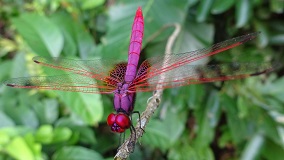
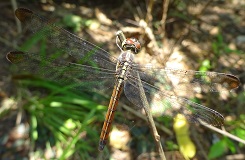
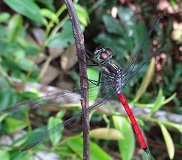 Contrary to the last visit, I did not capture any butterfly picture. Instead, I got 3 dragonflies this time round. It was common to
see dragonflies here since there were plenty of water around for them to lay their eggs. The one with red tail and dark body is a
male Grenadier (Agrionoptera insignis), the one with orange tail is a female Common Chaser (Potamarcha congener), and
the dark pink fellow is a male Crimson Dropwing (Trithemis aurora). Except for the Grenadier, the other 2 were new to me.
Contrary to the last visit, I did not capture any butterfly picture. Instead, I got 3 dragonflies this time round. It was common to
see dragonflies here since there were plenty of water around for them to lay their eggs. The one with red tail and dark body is a
male Grenadier (Agrionoptera insignis), the one with orange tail is a female Common Chaser (Potamarcha congener), and
the dark pink fellow is a male Crimson Dropwing (Trithemis aurora). Except for the Grenadier, the other 2 were new to me.
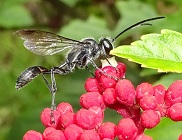
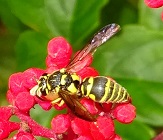
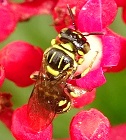
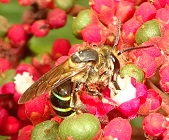 Many insects were seen visiting the red flowering heads of the Red Leea (Leea rubra).
Of them, my main interest was on the wasps and bees, especially those that I had yet to photograph. As usual, these creatures were
highly alert and tend not to stay on a flower for long. After sweating under the hot sun for around 15 minutes, I did manage to get
some reasonable pictures of 2 wasps and 2 bees. For the 2 wasps, the black fellow is a
Digger Wasp (Sphex cognatus) and the one with yellow strips and
marks was unknown to me, though I had seen them several times. As for the 2 bees, one is a small carpenter bee
(Ceratina species) while the other is a sweat bee (Lasioglossum species).
Many insects were seen visiting the red flowering heads of the Red Leea (Leea rubra).
Of them, my main interest was on the wasps and bees, especially those that I had yet to photograph. As usual, these creatures were
highly alert and tend not to stay on a flower for long. After sweating under the hot sun for around 15 minutes, I did manage to get
some reasonable pictures of 2 wasps and 2 bees. For the 2 wasps, the black fellow is a
Digger Wasp (Sphex cognatus) and the one with yellow strips and
marks was unknown to me, though I had seen them several times. As for the 2 bees, one is a small carpenter bee
(Ceratina species) while the other is a sweat bee (Lasioglossum species).

Later I spotted a small nest of paper wasp in a cleft of a slightly folded Simpoh Air leaf (Dillenia suffruticosa). It is likely to be a Ropalidia species, maybe Ropalidia fasciata or Ropalidia marginata.

 On the young frond of the Miding Fern (Stenochlaena palustris), I found this very tiny bronze colour Jewel Beetle. So far,
I had come across 2 other jewel beetles that feed on ferns,
Endelus bakerianus and
Endelus cupido. As for this bronze one, further check is needed
to determine whether it do feed on fern as well.
On the young frond of the Miding Fern (Stenochlaena palustris), I found this very tiny bronze colour Jewel Beetle. So far,
I had come across 2 other jewel beetles that feed on ferns,
Endelus bakerianus and
Endelus cupido. As for this bronze one, further check is needed
to determine whether it do feed on fern as well.
This ant with a dark navy blue gaster or abdomen was occasionally seen roaming on leaves and tree trunks. Their numbers were relatively few and it tended to roam alone. The colour of its gaster was the main differentiation feature from the other similar-looking ants in the area. A few weeks back, I managed to find a potential identity of this ant --- Polyrhachis aculeata.
I will probably share more of the findings next week if there is no other more exciting topic then.